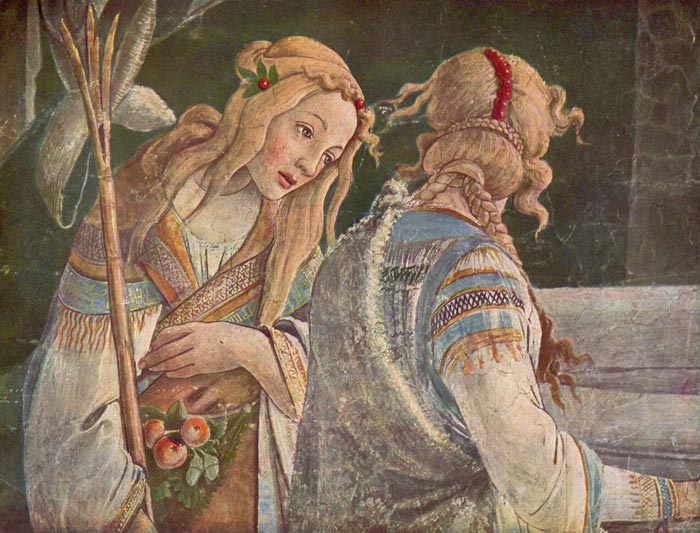
By Staff Middle Land
Sandro Botticelli, (1445-1510) was an Italian painter of the Florentine school during the Early Renaissance.
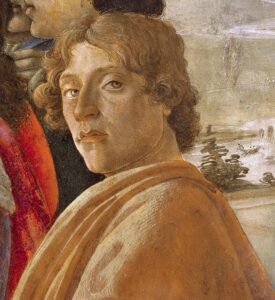
Less than a hundred years later, this movement, under the patronage of Lorenzo de’ Medici, was characterized by Giorgio Vasari as a “golden age”, a thought, suitably enough, he expressed at the head of his Vita of Botticelli. His posthumous reputation suffered until the late 19th century; since then his work has been seen to represent the linear grace of Early Renaissance painting. Among his best known works are The Birth of Venus and Primavera.
Details of Botticelli’s life are sparse, but we know that he became an apprentice when he was about fourteen years old, which would indicate that he received a fuller education than did other Renaissance artists. He was born in the city of Florence. Vasari reported that he was initially trained as a goldsmith by his brother Antonio. Probably by 1462 he was apprenticed to Fra Filippo Lippi; many of his early works have been attributed to the elder master, and attributions continue to be uncertain. Influenced also by the monumentality of Masaccio’s painting, it was from Lippi that Botticelli learned a more intimate and detailed manner. As recently discovered, during this time, Botticelli could have traveled to Hungary, participating in the creation of a fresco in Esztergom, ordered in the workshop of Fra Filippo Lippi by Vitéz János, then archbishop of Hungary.
By 1470 Botticelli had his own workshop. Even at this early date his work was characterized by a conception of the figure as if seen in low relief, drawn with clear contours, and minimizing strong contrasts of light and shadow which would indicate fully modeled forms.
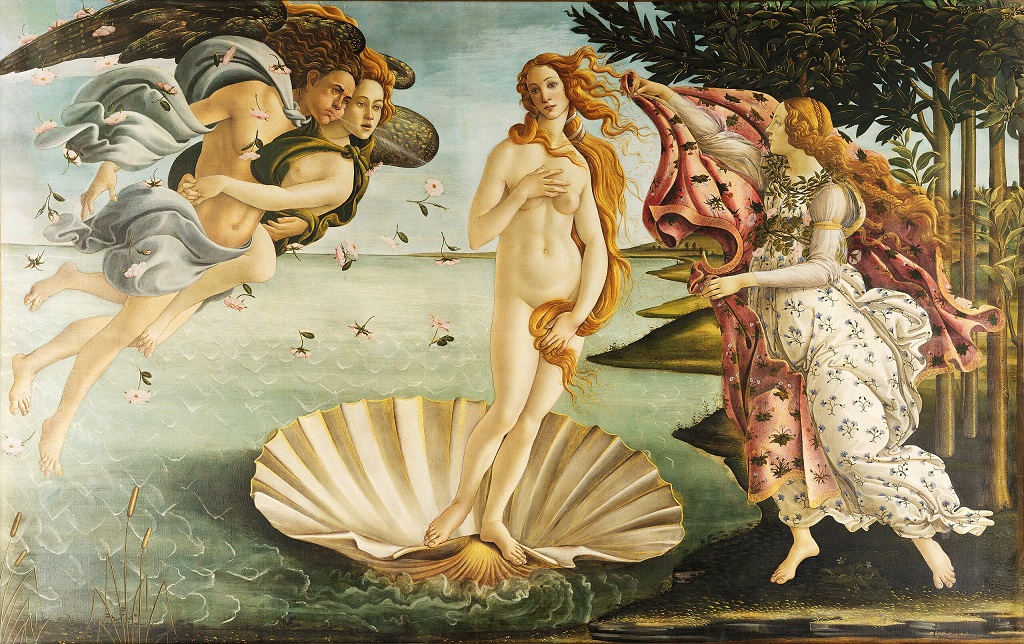
The masterworks Primavera (c. 1482) and The Birth of Venus (c. 1485) were both seen by Vasari at the villa of Lorenzo di Pierfrancesco de’ Medici at Castello in the mid-16th century, and until recently, it was assumed that both works were painted specifically for the villa. Recent scholarship suggests otherwise: the Primavera was painted for Lorenzo’s townhouse in Florence, and The Birth of Venus was commissioned by someone else for a different site. By 1499, both had been installed at Castello.
In these works, the influence of Gothic realism is tempered by Botticelli’s study of the antique. But if the painterly means may be understood, the subjects themselves remain fascinating for their ambiguity. The complex meanings of these paintings continue to receive widespread scholarly attention, mainly focusing on the poetry and philosophy of humanists who were the artist’s contemporaries. The works do not illustrate particular texts; rather, each relies upon several texts for its significance. Of their beauty, characterized by Vasari as exemplifying “grace” and by John Ruskin as possessing linear rhythm, there can be no doubt.
The Adoration of the Magi for Santa Maria Novella (c. 1475-1476, now at the Uffizi) contains the portraits of Cosimo de’ Medici (“the finest of all that are now extant for its life and vigour”), his grandson Giuliano de’ Medici, and Cosimo’s son Giovanni. The quality of the scene was hailed by Vasari as one of Botticelli’s pinnacles.
In 1481, Pope Sixtus IV summoned Botticelli and other prominent Florentine and Umbrian artists to fresco the walls of the Sistine Chapel. The iconological program was the supremacy of the Papacy. Sandro’s contribution was moderately successful. He returned to Florence, and “being of a sophistical turn of mind, he there wrote a commentary on a portion of Dante and illustrated the Inferno which he printed, spending much time over it, and this abstention from work led to serious disorders in his living.” Thus Vasari characterized the first printed Dante (1481) with Botticelli’s decorations; he could not imagine that the new art of printing might occupy an artist.
In the mid-1480s Botticelli worked on a major fresco cycle with Perugino, Ghirlandaio, and Filippino Lippi, for Lorenzo the Magnificent’s villa near Volterra; in addition he painted many frescoes in Florentine churches.
In 1491 Botticelli served on a committee to decide upon a facade for the Florence Duomo.
Influence of Savonarola

In later life, Botticelli was one of Savonarola’s followers, though the full extent of Savonarola’s influence is uncertain. The story that he burnt his own paintings on pagan themes in the notorious “Bonfire of the Vanities” is not told by Vasari, who nevertheless asserts that of the sect of Savonarola “he was so ardent a partisan that he was thereby induced to desert his painting, and, having no income to live on, fell into very great distress. For this reason, persisting in his attachement to that party, and becoming a Piagnone he abandoned his work.”. Botticelli biographer Ernst Steinman searched for the artist’s psychological development through his Madonnas. In the “deepening of insight and expression in the rendering of Mary’s physiognomy”, Steinman discerns proof of Savonarola’s influence over Botticelli. This means that the biographer needed to alter the dates of a number of Madonnas to substantiate his theory; specifically, they are dated ten years later than before. Steinman disagrees with Vasari’s assertion that Botticelli produced nothing after coming under the influence of Girolamo Savonarola. Steinman believes the spiritual and emotional Virgins rendered by Sandro follow directly from the teachings of the Dominican monk.
Death and Posthumous eclipse
Botticelli was already little employed in 1502. In 1504 he was a member of the committee appointed to decide where Michelangelo’s David would be placed. His later work, especially as seen in a series on the life of St. Zenobius, witnessed a diminution of scale, expressively distorted figures, and a non-naturalistic use of colour reminiscent of the work of Fra Angelico nearly a century earlier.
After his death his reputation was eclipsed longer and more thoroughly than that of any other major European artist. His paintings remained in the churches and villas for which they had been created, his frescoes in the Sistine Chapel upstaged by Michelangelo’s. British collector and art historian William Young Ottley however had brought Botticelli’s The Mystical Nativity to London with him in 1799 after buying it in Italy. After Ottley’s death its next purchaser allowed it to be exhibited in a major art exhibition held in Manchester in 1857, The Art Treasures Exhibition, where amongst many other art works it was viewed by more than a million people. The first nineteenth century art historian to have looked with satisfaction at Botticelli’s Sistine frescoes was Alexis-François Rio. Through Rio, Anna Brownell Jameson and Charles Eastlake were alerted to Botticelli, but, while works by his hand began to appear in German collections, both the Nazarene movement and the Pre-Raphaelite Brotherhood ignored him. Walter Pater created a literary picture of Botticelli, who was then taken up by the Aesthetic movement. The first monograph on the artist was published in 1893; then, between 1900 and 1920 more books were written on Botticelli than any other painter.
Private life
Botticelli never wed, and expressed a strong aversion to the idea of marriage, a prospect he claimed gave him nightmares.
The popular view is that he suffered from unrequited love for Simonetta Vespucci, a married noblewoman. According to legend, she had served as the model for The Birth of Venus and recurs throughout his paintings, despite the fact that she had died years earlier, in 1476. Botticelli asked that when he die he be buried at her feet in the Church of Ognissanti in Florence. His wish was carried out when he died some 34 years later, in 1510.
Some modern historians have also examined other aspects of his sexuality. In 1938, Jacques Mesnil discovered a summary of a charge in the Florentine Archives for November 16, 1502 which read simply, “Botticelli keeps a boy”; under an accusation of [sodomy]. The painter would then have been fifty-eight; the charges were eventually dropped. Mesnil dismissed it as a customary slander by which partisans and adversaries of Savonarola abused each other. Opinion remains divided on whether this is evidence of homosexuality. Many have firmly backed Mesnil, but others have cautioned against hasty dismissal of the charge. Yet while speculating on the subject of his paintings, Mesnil nevertheless concluded “woman was not the only object of his love”.
The Birth of Venus
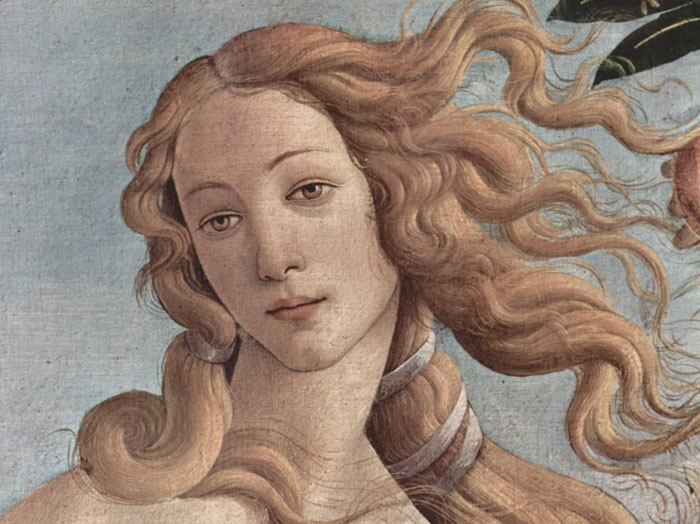
A close-up of the Venus figure in Botticelli’s legendary The Birth of Venus. Botticelli’s model for his most famous art work was the beautiful Simonetta Vespucci. Once nominated “The Queen of Beauty” at a Florentine jousting tournament, it was Simonetta’s face that Botticelli painted on an art banner.
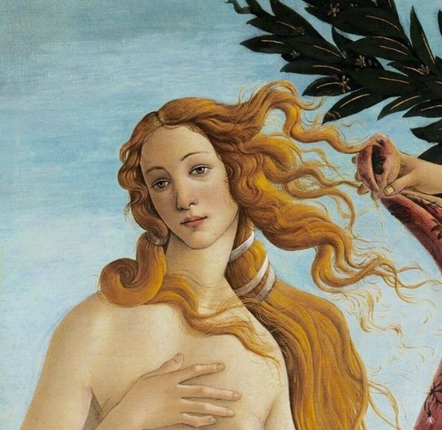
The art banner was carried into battle by the tournament winner, Giuliano de’ Medici, a man soon to become her lover. Inscribed beneath her image, Botticelli described her as “the unparalleled one.”
Only shortly after her arrival in Florence, Simonetta became known as “La Bella Simonetta,” attracting the attention of poets and artists like Botticelli. They vied to honor her with their artistic creations. At the age of fifteen, Simonetta married a cousin of Amerigo Vespucci, the famous Italian explorer for whom America was named. It was through the Vespucci family connection that Simonetta first met Botticelli and the Medici family, prominent political figures and art patrons.
Simonetta, “the unparalleled one,” personified ideal beauty
The face of Simonetta personified the Italian Renaissance concept of ideal beauty. This was important to artists like Botticelli, who thought that outward beauty reflected inner beauty or virtue (spiritual beauty). Simonetta died in 1476 at the age of twenty-two, but Botticelli continued to feature her image in his art for the rest of his life. All of Botticelli’s female art images were portraits of Simonetta. Upon his death three decades later, Botticelli requested to be buried at Simonetta’s feet.
Primavera
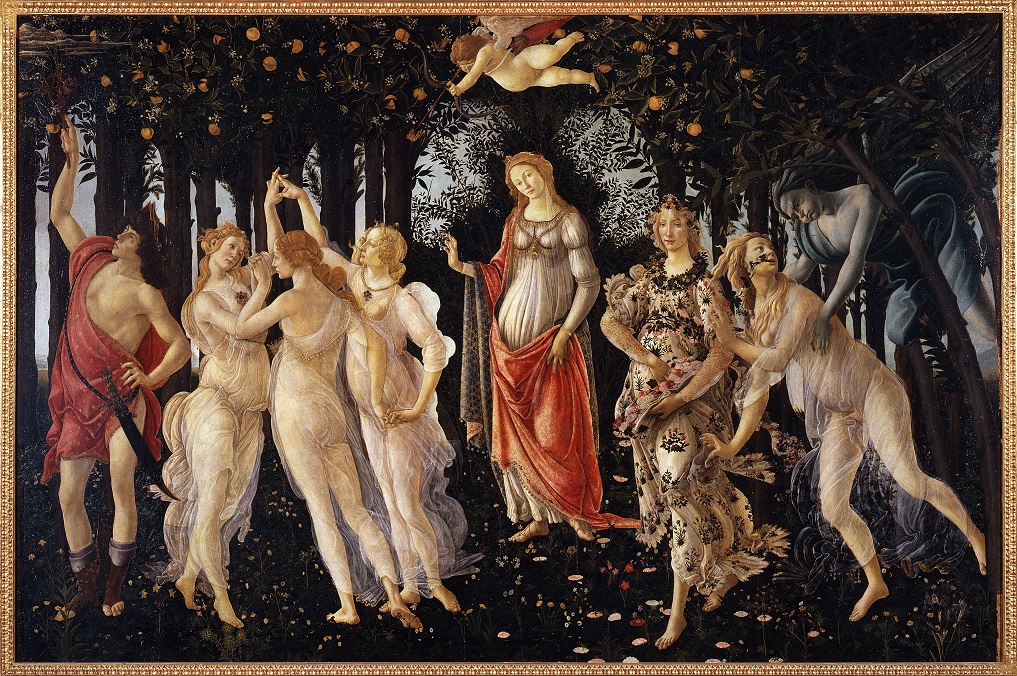
Botticelli painted Primavera for Lorenzo di Pierfrancesco de’ Medici (1463–1503), one of Lorenzo the Magnificent’s cousins. Venus stands just to the right of center with her son Cupid hovering above her head. Botticelli drew attention to Venus by opening the landscape behind her to reveal a portion of sky that forms a kind of halo around the goddess of love’s head.
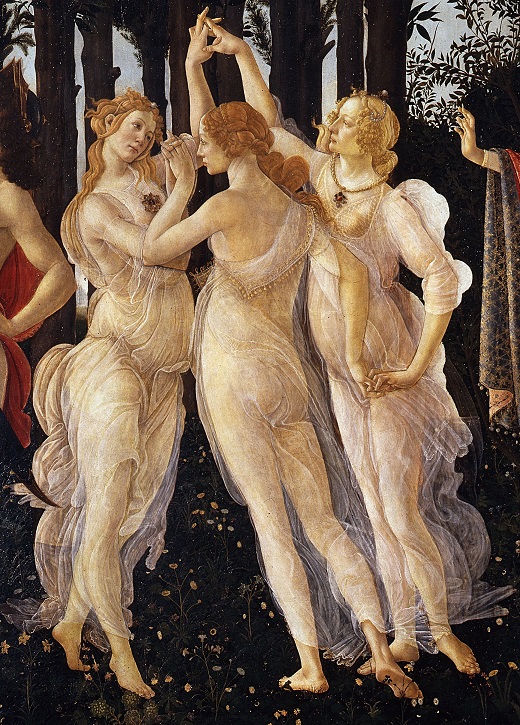
To her right, seemingly the target of Cupid’s arrow, are the dancing Three Graces, based closely on ancient prototypes but clothed,albeit in thin, transparent garments. At the right, the blue ice-cold Zephyrus, the west wind, is about to carry off and marry the nymph Chloris, whom he transforms into Flora, goddess of spring, appropriately shown wearing a rich floral gown. At the far left, the enigmatic figure of Mercury turns away from all the others and reaches up with his distinctive staff, the caduceus, perhaps to dispel storm clouds. The sensuality of the representation, the appearance of Venus in springtime, and the abduction and marriage of Chloris all suggest the occasion for the painting was young Lorenzo’s wedding in May 1482. But the painting also sums up the Neo-Platonists’ view that earthly love is compatible with Christian theology. In their reinterpretation of classical mythology, Venus as the source of love provokes desire through Cupid. Desire can lead either to lust and violence (Zephyr) or, through reason and faith (Mercury), to the love of God. Primavera, read from right to left, served to urge the newlyweds to seek God through love.[Source: The Renaissance in Quattrocento Italy. Chapter 21, p.559]
At the height of his fame, the Florentine painter and draughtsman Sandro Botticelli was one of the most esteemed artists in Italy.
In the Uffizi there is a painting by Sandro Botticelli which is both a portrait of the Medici family and a self-portrait of the artist. It is the celebrated Adoration of tlre Magi, painted around the year 1475 for the chapel patronized by the Lama (or Lami) family in Santa Maria Novella. It is the picture that, according to Vasari, made the young Sandro famous in Florence and Italy and opened the way to Rome.
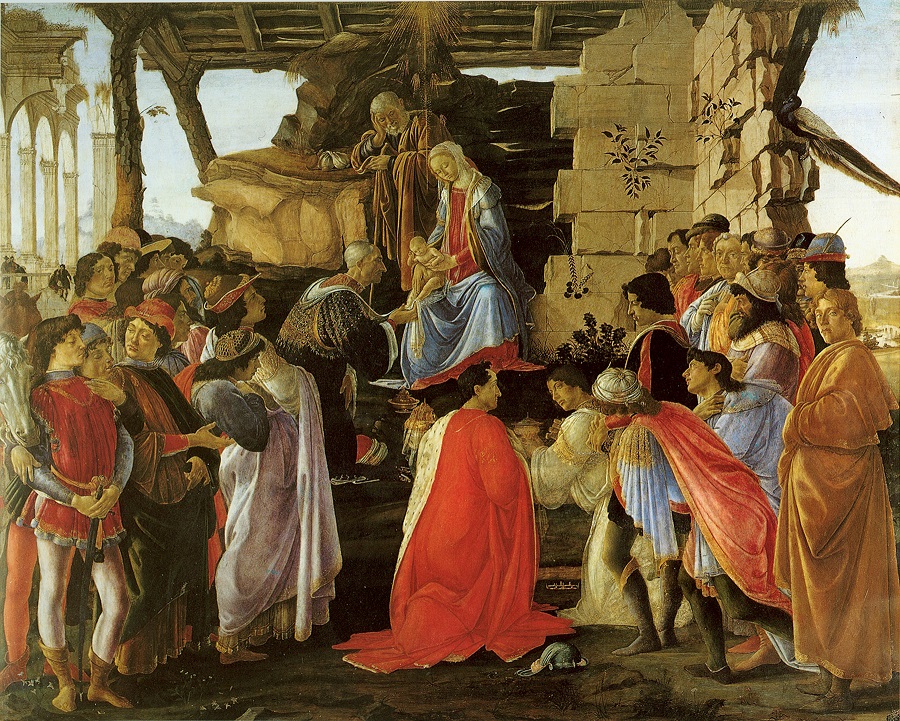
The painting is based on a subtle web of symbolic references. The Lami Chapel was dedicated to the Epiphany because the client’s name, Gaspare, was the same as the one traditionally attributed to one of the three Magi. This explains the choice of the iconographic subject. The Adoration of the Magi theme was popular in the Renaissance Florence.
In the scene are present numerous characters among which are several members of the Medici family: Cosimo de’ Medici (the Magus kneeling in front of the Virgin, described by Vasari as “the finest of all that are now extant for its life and vigour”), his sons Piero (the second Magus kneeling in the centre with the red mantle) and Giovanni (the third Magus), and his grandsons Giuliano and Lorenzo.
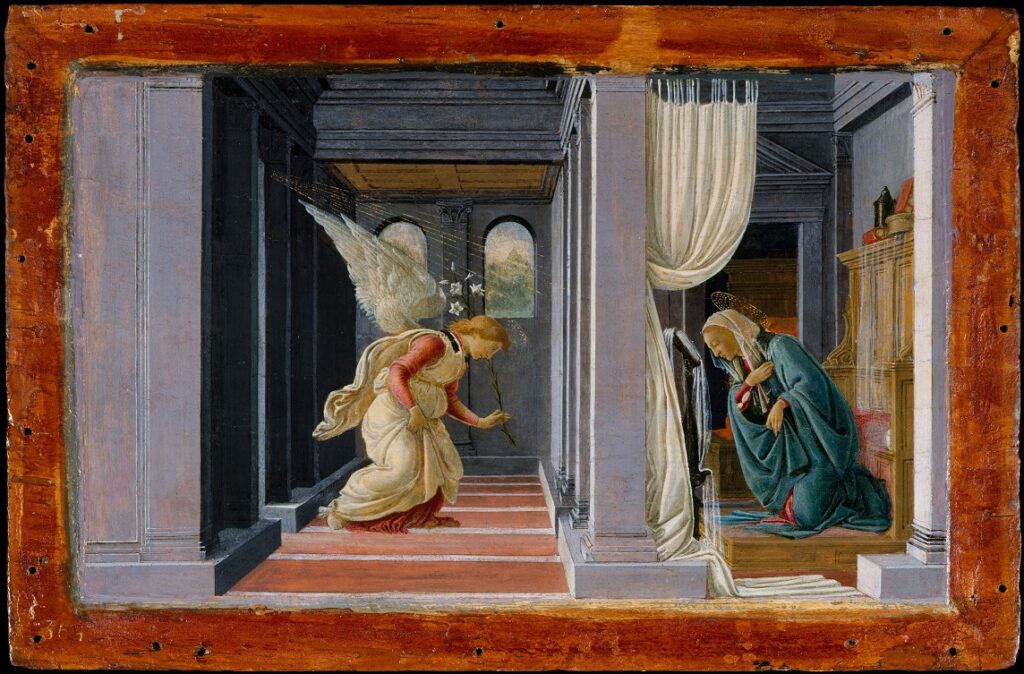
The Met says regarding this work: One of the most celebrated paintings in the Robert Lehman Collection, this depiction of the Annunciation unfolds in a classicizing architectural interior rendered with one-point perspective to create the illusion of depth, a technique achieved in early fifteenth-century Florence. The incised lines visible on the panel’s surface are evidence of Botticelli’s working method to create the complex composition. A row of pillars divides the space occupied by the Angel Gabriel from the intimate bed chamber of the Virgin, who kneels in humility as she receives his divine message. The panel was almost certainly commissioned as a private devotional image, not as part of a larger work. While the identity of the patron is not known, the painting was in the famed Barberini collection in Rome in the seventeenth century.
Original article: travelingintuscany.com






Cancel anytime


Using our website
You may use the The Middle Land website subject to the Terms and Conditions set out on this page. Visit this page regularly to check the latest Terms and Conditions. Access and use of this site constitutes your acceptance of the Terms and Conditions in-force at the time of use.
Intellectual property
Names, images and logos displayed on this site that identify The Middle Land are the intellectual property of New San Cai Inc. Copying any of this material is not permitted without prior written approval from the owner of the relevant intellectual property rights.
Requests for such approval should be directed to the competition committee.
Please provide details of your intended use of the relevant material and include your contact details including name, address, telephone number, fax number and email.
Linking policy
You do not have to ask permission to link directly to pages hosted on this website. However, we do not permit our pages to be loaded directly into frames on your website. Our pages must load into the user’s entire window.
The Middle Land is not responsible for the contents or reliability of any site to which it is hyperlinked and does not necessarily endorse the views expressed within them. Linking to or from this site should not be taken as endorsement of any kind. We cannot guarantee that these links will work all the time and have no control over the availability of the linked pages.
Submissions
All information, data, text, graphics or any other materials whatsoever uploaded or transmitted by you is your sole responsibility. This means that you are entirely responsible for all content you upload, post, email or otherwise transmit to the The Middle Land website.
Virus protection
We make every effort to check and test material at all stages of production. It is always recommended to run an anti-virus program on all material downloaded from the Internet. We cannot accept any responsibility for any loss, disruption or damage to your data or computer system, which may occur while using material derived from this website.
Disclaimer
The website is provided ‘as is’, without any representation or endorsement made, and without warranty of any kind whether express or implied.
Your use of any information or materials on this website is entirely at your own risk, for which we shall not be liable. It is your responsibility to ensure any products, services or information available through this website meet your specific requirements.
We do not warrant the operation of this site will be uninterrupted or error free, that defects will be corrected, or that this site or the server that makes it available are free of viruses or represent the full functionality, accuracy and reliability of the materials. In no event will we be liable for any loss or damage including, without limitation, loss of profits, indirect or consequential loss or damage, or any loss or damages whatsoever arising from the use, or loss of data, arising out of – or in connection with – the use of this website.
Last Updated: September 11, 2024
New San Cai Inc. (hereinafter “The Middle Land,” “we,” “us,” or “our”) owns and operates www.themiddleland.com, its affiliated websites and applications (our “Sites”), and provides related products, services, newsletters, and other offerings (together with the Sites, our “Services”) to art lovers and visitors around the world.
This Privacy Policy (the “Policy”) is intended to provide you with information on how we collect, use, and share your personal data. We process personal data from visitors of our Sites, users of our Services, readers or bloggers (collectively, “you” or “your”). Personal data is any information about you. This Policy also describes your choices regarding use, access, and correction of your personal information.
If after reading this Policy you have additional questions or would like further information, please email at middleland@protonmail.com.
PERSONAL DATA WE COLLECT AND HOW WE USE IT
We collect and process personal data only for lawful reasons, such as our legitimate business interests, your consent, or to fulfill our legal or contractual obligations.
Information You Provide to Us
Most of the information Join Talents collects is provided by you voluntarily while using our Services. We do not request highly sensitive data, such as health or medical information, racial or ethnic origin, political opinions, religious or philosophical beliefs, trade union membership, etc. and we ask that you refrain from sending us any such information.
Here are the types of personal data that you voluntarily provide to us:
As a registered users or customers, you may ask us to review or retrieve emails sent to your business. We will access these emails to provide these services for you.
We use the personal data you provide to us for the following business purposes:
Information Obtained from Third-Party Sources
We collect and publish biographical and other information about users, which we use to promote the articles and our bloggers who use our sites. If you provide personal information about others, or if others give us your information, we will only use that information for the specific reason for which it was provided.
Information We Collect by Automated Means
Log Files
The site uses your IP address to help diagnose server problems, and to administer our website. We use your IP addresses to analyze trends and gather broad demographic information for aggregate use.
Every time you access our Site, some data is temporarily stored and processed in a log file, such as your IP addresses, the browser types, the operating systems, the recalled page, or the date and time of the recall. This data is only evaluated for statistical purposes, such as to help us diagnose problems with our servers, to administer our sites, or to improve our Services.
Do Not Track
Your browser or device may include “Do Not Track” functionality. Our information collection and disclosure practices, and the choices that we provide to customers, will continue to operate as described in this Privacy Policy, whether or not a “Do Not Track” signal is received.
HOW WE SHARE YOUR INFORMATION
We may share your personal data with third parties only in the ways that are described in this Privacy Policy. We do not sell, rent, or lease your personal data to third parties, and We does not transfer your personal data to third parties for their direct marketing purposes.
We may share your personal data with third parties as follows:
There may be other instances where we share your personal data with third parties based on your consent.
HOW WE STORE AND SECURE YOUR INFORMATION
We retain your information for as long as your account is active or as needed to provide you Services. If you wish to cancel your account, please contact us middleland@protonmail.com. We will retain and use your personal data as necessary to comply with legal obligations, resolve disputes, and enforce our agreements.
All you and our data are stored in the server in the United States, we do not sales or transfer your personal data to the third party. All information you provide is stored on a secure server, and we generally accepted industry standards to protect the personal data we process both during transmission and once received.
YOUR RIGHTS/OPT OUT
You may correct, update, amend, delete/remove, or deactivate your account and personal data by making the change on your Blog on www.themiddleland.com or by emailing middleland@protonmail.com. We will respond to your request within a reasonable timeframe.
You may choose to stop receiving Join Talents newsletters or marketing emails at any time by following the unsubscribe instructions included in those communications, or you can email us at middleland@protonmail.com
LINKS TO OTHER WEBSITES
The Middle Land include links to other websites whose privacy practices may differ from that of ours. If you submit personal data to any of those sites, your information is governed by their privacy statements. We encourage you to carefully read the Privacy Policy of any website you visit.
NOTE TO PARENTS OR GUARDIANS
Our Services are not intended for use by children, and we do not knowingly or intentionally solicit data from or market to children under the age of 18. We reserve the right to delete the child’s information and the child’s registration on the Sites.
PRIVACY POLICY CHANGES
We may update this Privacy Policy to reflect changes to our personal data processing practices. If any material changes are made, we will notify you on the Sites prior to the change becoming effective. You are encouraged to periodically review this Policy.
HOW TO CONTACT US
If you have any questions about our Privacy Policy, please email middleland@protonmail.com
The Michelin brothers created the guide, which included information like maps, car mechanics listings, hotels and petrol stations across France to spur demand.
The guide began to award stars to fine dining restaurants in 1926.
At first, they offered just one star, the concept was expanded in 1931 to include one, two and three stars. One star establishments represent a “very good restaurant in its category”. Two honour “excellent cooking, worth a detour” and three reward “exceptional cuisine, worth a
Thank you for your participation,
please Log in or Sign up to Vote

123Sign in to your account